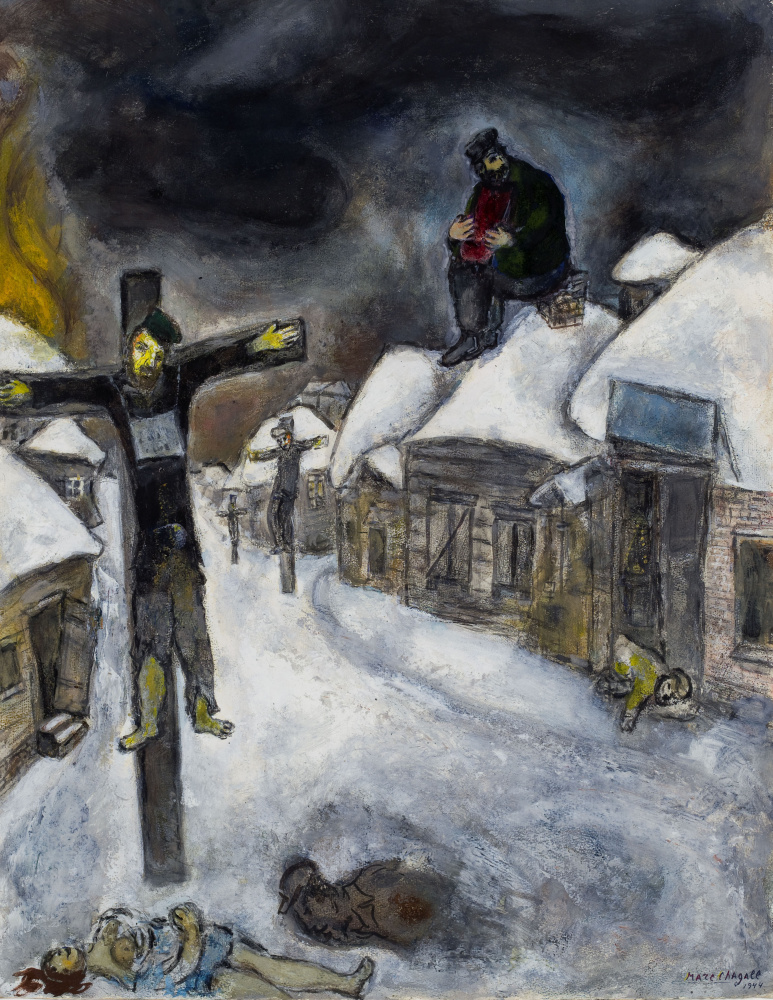JERUSALEM — At the center of the Israel Museum’s newest art exhibit stands an imposing, life-size marble figure of Jesus Christ. The sculpture, titled “Christ Before the People’s Court,” would not be out of place in a church in Rome.
Yet in this depiction, the Christian savior wears a Jewish skullcap.
The sculpture, created by Russian Jewish artist Mark Antokolsky in 1876, is part of a collection of more than 150 artworks by 40 Jewish and Israeli artists who have used Christian imagery to challenge long-held taboos in both communities. It showcases the evolving attitudes of Jewish, Zionist and Israeli artists toward a figure whose place in Jewish history has been negotiated and reinterpreted over more than two millennia.
It is a risky statement for an Israeli museum.
Throughout history, Jews have traditionally shunned Jesus and his gospel. And while the Holy Land might be his accepted birthplace, for Jews in the modern state of Israel there is often resistance to learning about or even acknowledging Christianity. This stems mainly from a fear of centuries old anti-Semitism, especially in Europe, where the crucifixion of Jesus was used as an excuse to persecute Jews.
“We are talking about a 2,000-year-old tension between Judaism and Christianity and the fact that anti-Semitism grew in Christian thought and theology,” said the exhibition’s curator, Amitai Mendelsohn.
Mendelsohn said he was surprised at just how many Jewish artists throughout history, and today in Israel, have used Jesus and Christian themes as inspirations for their work.
It is a delicate subject for Jews everywhere, including in Israel, but artists by nature “are attracted to something that is forbidden for them,” he said.
Ziva Amishai-Maisels, a professor emeritus at the Hebrew University in Jerusalem who specializes in Christian imagery in Jewish art, said that religious Jews, who might be opposed to such depictions, would probably stay away from the exhibition. “Those who do go might be stunned,” she said, “but I don’t think they will react badly.”
Some of the works, though, could offend pious Christians, she said. “They might feel the images are sacrilegious, but the wall texts are explanatory enough – if they read them, it should calm them down.”
While some of the older works by European Jews challenge Christian anti-Semitism or look at how Jesus’ Jewish roots could act as a bridge between the religions, more contemporary pieces explore Jesus as an anti-establishment figure, who suffered not being understood.
Ronit Steinberg, an art historian from Jerusalem’s Bezalel Academy of Arts and Design, said the appeal for Jewish artists in depicting Christ has changed over the years, but all are tied together by a common thread.
“In the 19th century, the main issue was the Jewish artist feeling emancipated, and it was important for those artists to connect with their surrounding and the time. For Israeli artists, it’s also a kind of emancipation from the heavy Jewishness of their country,” she said.
There’s the “Yellow Crucifixion,” a 1943 Marc Chagall painting showing Jesus Christ as a Jew. Hued in yellow, perhaps representing the star the Nazis forced Jews to wear, Jesus is strung from a cross wrapped in a Jewish prayer shawl and phylacteries.
Another artist, Moshe Hoffman, a Hungarian Jew who survived the Holocaust, used his art to question Christianity’s role in the genocide. In one work, “Six million and 1,” Hoffman shows a Nazi guard attempting to pull Jesus from the cross to make him Jewish prisoner number 6,000,001.
Others used Jesus as a Jew to connect their Jewish identity to Christian surroundings. While Antokolsky was the first Russian Jewish artist to be accepted by his peers, he suffered an identity crisis from being Jewish and Russian.
Send questions/comments to the editors.



Success. Please wait for the page to reload. If the page does not reload within 5 seconds, please refresh the page.
Enter your email and password to access comments.
Hi, to comment on stories you must . This profile is in addition to your subscription and website login.
Already have a commenting profile? .
Invalid username/password.
Please check your email to confirm and complete your registration.
Only subscribers are eligible to post comments. Please subscribe or login first for digital access. Here’s why.
Use the form below to reset your password. When you've submitted your account email, we will send an email with a reset code.